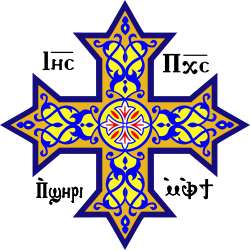- Illuminated early form of Coptic cross at the end of the 4th–5th century Coptic Codex Glazier
- 5th-century liturgical Coptic relief featuring the Coptic crux ansata
- Wall painting of a jewelled cross (Kellia, Egypt, late 6th century)
- Coptic cross from the Ancient Egyptian Temple of Philae
- Basic abstract equal-armed cross design with circle at center and surrounded by 4 nails. Called a "Coptic" cross by Rudolf Koch in his The Book of Signs (Dover); may not be prominent in Coptic Christian symbolism in this form.
- Ethiopian Orthodox Processional cross from the Amhara Region (mid-20th century)
- Coptic priest holding a hand-held blessing cross (Cairo, 2010)

Coptic letters (Ⲓⲏ̅ⲥ̅ Ⲡⲭ̅ⲥ̅ Ⲡ̀ϣⲏⲣⲓ ⲙ̀ⲪϮ) are abbreviated nomina sacra for "Ⲓⲏⲥⲟⲩⲥ Ⲡⲓⲭ̀ⲣⲓⲥⲧⲟⲥ Ⲡ̀ϣⲏⲣⲓ ⲙ̀Ⲫ̀ⲛⲟⲩϯ" (Iêsous Piekhristos Epshêri Emefnouti; Jesus Christ, Son of God)
The Coptic cross is any of a number of Christian cross variants associated in some way with Coptic Christians. [2]








